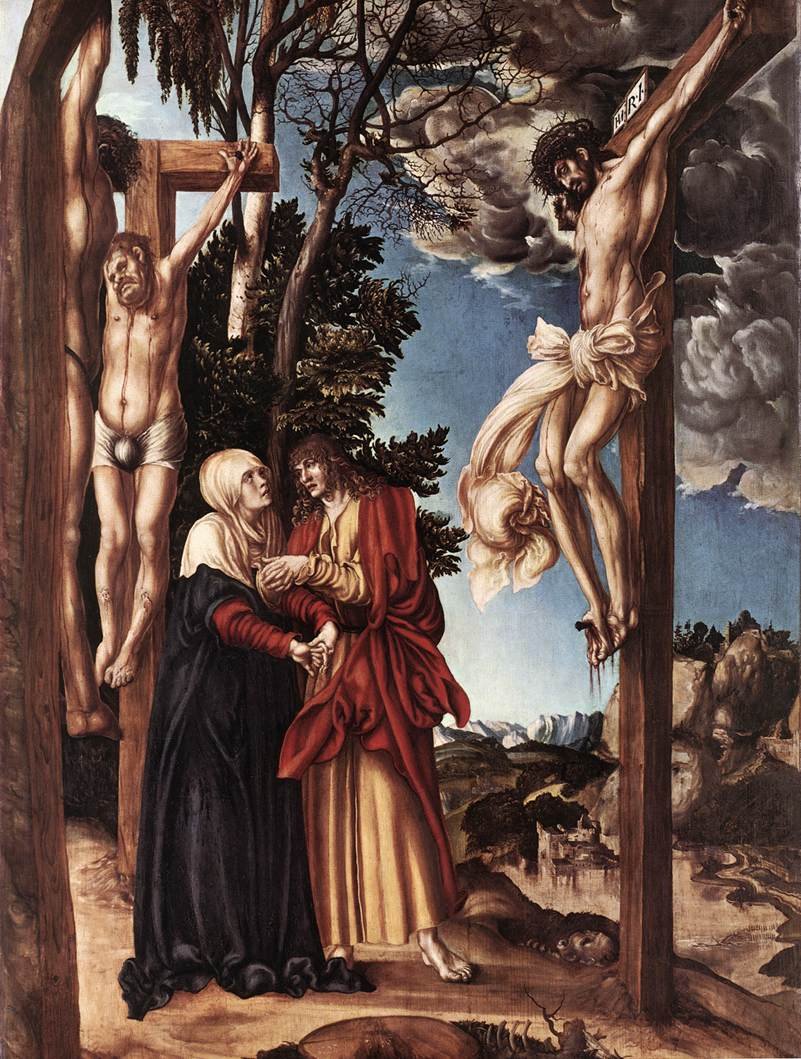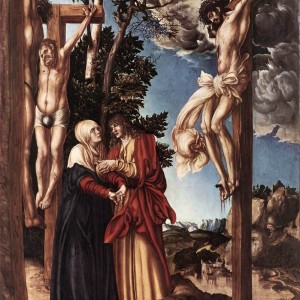
As I was finishing my time in prayer in our adoration chapel last night, I said goodnight to the other man in the chapel. He told me that it was good to see a priest in there praying and asked me to wait a minute. He pulled out his wallet and took out a bill. He told me that he wanted me to offer a Mass for the cause of Fulton Sheen’s canonization on December 9, 2009 (the 30th Anniversary of Sheen’s death). At that point, he shared how important the daily holy hour was to Bishop Sheen (a point I had heard earlier in the day emphasized by Fr. John Corapi on the radio). He then asked if I had read Sheen’s “Life of Christ.” I told him that I owned the book but haven’t read it yet. He then said to look up on page 544 the “Second Word of Christ on the Cross.” He then when on to quote almost verbatim this passage in which Sheen describes the scene in Luke 23: 39-43:
A dying man asked a dying man for eternal life; a man without possessions asked a poor man for a Kingdom; a thief at the door of death asked to die like a thief and steal Paradise. One would have thought a saint would have been the first soul purchased over the counter of Calvary by the red coins of Redemption, but in the Divine plan it was a thief who was the escort of the King of kings into Paradise.
When I got back to the rectory and went down to my man cave (AKA basement suite), I pulled out the book and opened it to page 544. I was stunned. The devotion of the adorer I spoke with in the chapel obviously caught me off guard. However, the depth of reflection by Bishop Sheen on this passage was astonishing. Obviously, I was experiencing the fruit of years of prayer and study by a dedicated disciple. A life spent in adoration before the Blessed Sacrament.
Sheen constantly talked about the importance of the daily Holy Hour for his life and the life of all priests. When asked about why the daily Holy Hour with Christ in the Eucharist is so important, he related a story that I have retold many times:
A couple of months before his death he was interviewed on national television. One of the questions was this: “Bishop Sheen, you have inspired millions of people all over the world. Who inspired you? Was it a Pope?”Bishop Sheen responded that it was not a Pope, a Cardinal, another Bishop, or even a priest or a nun. It was a little Chinese girl of eleven years of age. He explained that when the Communists took over China, they imprisoned a priest in his own rectory near the Church.
After they locked him up in his own house, the priest was horrified to look out of his window and see the Communists proceed into the Church, where they went into the sanctuary and broke into the tabernacle. In an act of hateful desecration, they took the ciborium and threw it on the floor with all of the Sacred Hosts spilling out. The priest knew exactly how many Hosts were in the ciborium: thirty-two.
When the Communists left, they either did not notice, or didn’t pay any attention to a small girl praying in the back of the Church who saw everything that had happened.
That night the little girl came back. Slipping past the guard at the priest’s house, she went inside the Church. There she made a holy hour of prayer, an act of love to make up for the act of hatred. After her holy hour she went into the sanctuary, knelt down, bent over and with her tongue received Jesus in Holy Communion, since it was not permissible at that time for laymen to touch the Sacred Host with their hands.
The little girl continued to come back each night to make her holy hour and receive Jesus in Holy Communion on her tongue. On the thirty-second night, after she had consumed the last and thirty-second host, she accidentally made a noise and woke the guard who was sleeping. He ran after her, caught her, and beat her to death with the butt of his rifle.
This act of heroic martyrdom was witnessed by the priest as he watched grief-stricken from his bedroom window.
When Bishop Sheen heard the story he was so inspired that he promised God he would make a holy hour of prayer before Jesus in the Blessed Sacrament everyday of his life. If this little Chinese girl could risk her life everyday to express her love for Jesus in the Blessed Sacrament with a holy hour and Holy Communion, then, at the very least, the Bishop thought he should do the same.
In this Year for Priests, hopefully all priests will deepen our appreciation of the Eucharist and foster a greater devotion to Eucharistic Adoration.
As a closing comment, on this memorial of St. Pio of Pietrelcina, it is important to remember that the stigmata that Padre Pio had received were given to him especially for the sanctification of those living a consecrated life to God. As new discoveries uncovered:
Asked to swear on the Gospel, Padre Pio for the first time revealed the identity of the one from whom he received the wounds.
It was June 15, 1921, and in answer to a question posed by Bishop Rossi, Padre Pio said: “On Sept. 20, 1918, I was in the choir of the church after celebrating Mass, making the thanksgiving when I was suddenly overtaken by powerful trembling and then there came calm and I saw Our Lord in his crucified form.
“He was lamenting the ingratitude of men, especially those consecrated to him and favored by him.”
“Then,” Padre Pio continued, “his suffering was apparent as was his desire to join souls to his Passion. He invited me to let his pains enter into me and to meditate on them and at the same time concern myself with the salvation of others. Following this, I felt full of compassion for the Lord’s pains and I asked him what I could do.
“I heard this voice: ‘I will unite you with my Passion.’ And after this the vision disappeared, I came back to myself, my reason returned and I saw these signs here from which blood flowed. Before this I did not have these.”
Padre Pio then said that the stigmata were not the result of a personal request of his own but came from an invitation of the Lord, who, lamenting the ingratitude of men, and consecrated persons in particular, conferred on Padre Pio a mission as the culmination of an interior mystical journey of preparation.
Personally, I can’t think of a better way to develop a deeper gratitude for the “red coins of Redemption” than to thank Jesus daily in adoration of the Blessed Sacrament.

Wow, what a great post her, Father. That Bishop Sheen story is a new one to me, though not his Life of Christ – that book is pure genius. I pray for his canonization also. Glad you’re here at Shameless Popery, God bless you.
I second everything that Christopher said. Of course, I love Bp. Fulton Sheen and Padre Pio, so you’re playing a couple of my favorite tunes.
I loved the homily, too (it’s here, http://chirb.it/g4ame8, for anyone who overlooked it). It was outstanding. Do you have any Word doc notes from it or anything that you could post? I’m not really sure how you prepare for your homilies normally.
Unfortunately Joe, I don’t have any notes typed up. I just use a rough outline to preach from…that becomes more obvious at the points you hear me get tongue tied.
I may have to work on a dedicated post with the themes involved though.
Thanks for the comments guys!
I have been looking for years for this passage about “the red coins of redemption” which I read while looking at books at the public library 20 years ago. I always remembered the line about dieing like a thief and stealing heaven.
You will notice that if your Google “red coins of redemption” you are the only one that pops up and you have only been around since April of 2009.
I have a holy card blog (click on my name above) that features holy cards. Hope you might check it out.
Thank you, thank you, thank you for guiding me to Bishop Sheen’s Book.